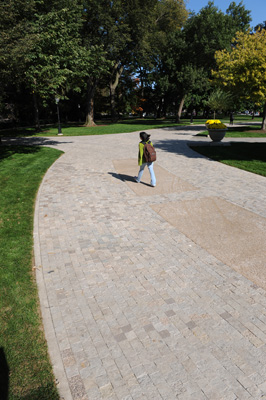| Sun | Mon | Tue | Wed | Thu | Fri | Sat |
|---|---|---|---|---|---|---|
| 1 | 2 | 3 | 4 | 5 | ||
| 6 | 7 | 8 | 9 | 10 | 11 | 12 |
| 13 | 14 | 15 | 16 | 17 | 18 | 19 |
| 20 | 21 | 22 | 23 | 24 | 25 | 26 |
| 27 | 28 | 29 | 30 | 31 |
CATEGORIES
RECENT ENTRIES
BLOG ROLL
In which we protest too much
Defending the U of C against a bad first impression
After a recent report of students failing to spontaneously burst into song in the presence of prospective applicants, UChiBlogo suggests the following minimum guidelines for public displays of enthusiasm:
1. Smile. Doesn’t matter about what. Corollary: Travel in groups, preferably boisterous ones recounting last night’s Colbert Report or the latest episode of The New Adventures of Old Christine.
2. End as many sentences as possible with the phrase “on our campus near the shore of Lake Michigan.” Example: “I enjoy the educational challenges at the University of Chicago, but also the many exciting extracurricular activities and lasting friendships I’ve made on our campus near the shore of Lake Michigan.”
3. If your parents happened to meet here, consider erecting a memorial on the spot to illustrate that love can blossom amid the otherwise soulless rigor of the University of Chicago.
4. When referencing famous alumni—every student should work at least two into daily conversation—avoid Nobel laureates and Pulitzer winners. Focus on contemporary entertainers. Tucker Max, AB’98, for example.
These are not idle suggestions. The perceived lack of a palpably happy spirit—and, apparently, a dearth of comedy-star alums—cost the U of C an applicant. Caren Osten Gerszberg explained why on the New York Times blog “The Choice: Demystifying College Admissions and Aid.”
 On a trip to Chicago, Gerszberg and her daughter, a high-school junior, visited both the U of C and Northwestern. In Hyde Park the campus tour alone convinced Gerszberg’s daughter the school was not for her. “I just don’t feel it in my soul,” she said during the tour, because “everyone is walking alone.” She asked her mom if they could skip the subsequent information session. Those sessions are supposed to be before the tours now, which only deepens the mystery of who knew what and when they knew it.
On a trip to Chicago, Gerszberg and her daughter, a high-school junior, visited both the U of C and Northwestern. In Hyde Park the campus tour alone convinced Gerszberg’s daughter the school was not for her. “I just don’t feel it in my soul,” she said during the tour, because “everyone is walking alone.” She asked her mom if they could skip the subsequent information session. Those sessions are supposed to be before the tours now, which only deepens the mystery of who knew what and when they knew it.
Gerszberg pondered how much influence she should exert over her daughter’s decisions. “As a mother I feel like it’s my job to lead her through situations with which she may need guidance—to be the grown-up who seems to know all the answers. Even though I clearly don’t.” This time she deferred rather than urging her daughter to “sit through an hour-long info session.”
An hour would have been a waste of time after she had concluded from the expressions of—what, a hundred kids on the quads?—that U of C students were humorless loners. Her daughter’s intuition rang true, Gerszberg writes, because the students “rushing from class to class and library to library did not appear to be smiling.”
Meanwhile, their experience on the Evanston campus “along the shore of Lake Michigan” included cooler name-dropping—Stephen Colbert and Julia Louis-Dreyfus compared to the Chicago guide's mention of Carl Sagan, AB’54, SB’55, SM’56, PhD’60—and, presumably, more apparent smiles. They stuck around for the information session.
Never mind that the “chatty” Northwestern tour guide’s story about his parents meeting on campus was an irrelevant coincidence; or that if Sagan were alive today he’d probably be a regular Colbert guest. Sagan’s novel, Contact, was made into a movie, so it couldn’t have been that boring. Matthew McConaughey was in it, and he seems like he’s always up for some hacky-sack. It follows, then, that McConaughey’s interest in Sagan’s story makes him a U of C kind of guy, which makes it a hacky-sack kind of place.
That must have been covered in the information session.
Jason Kelly
May 26, 2010
